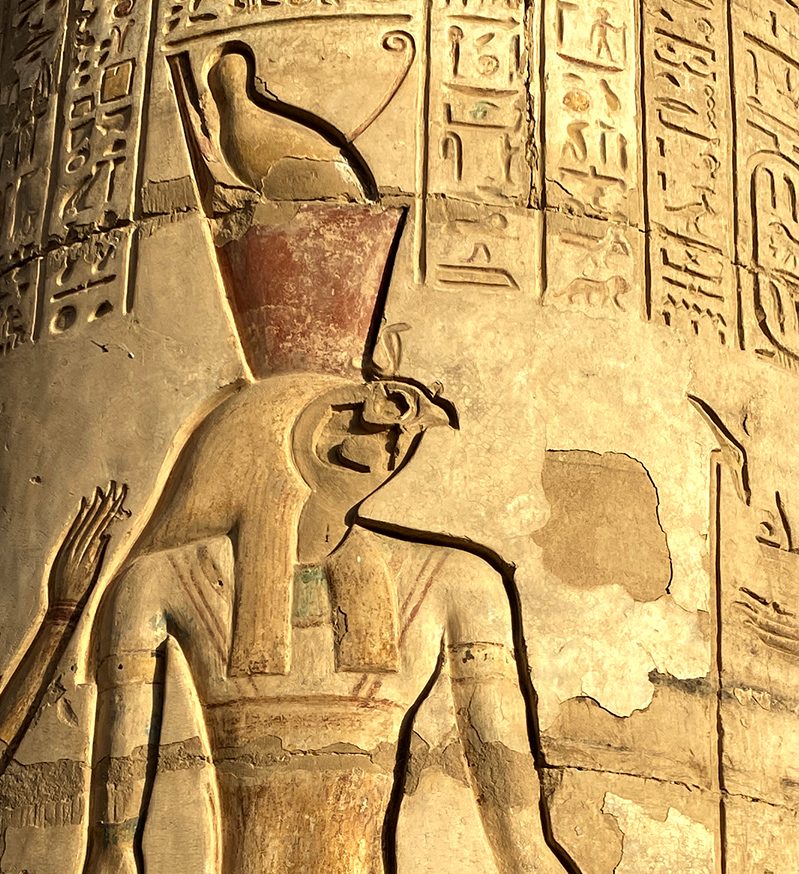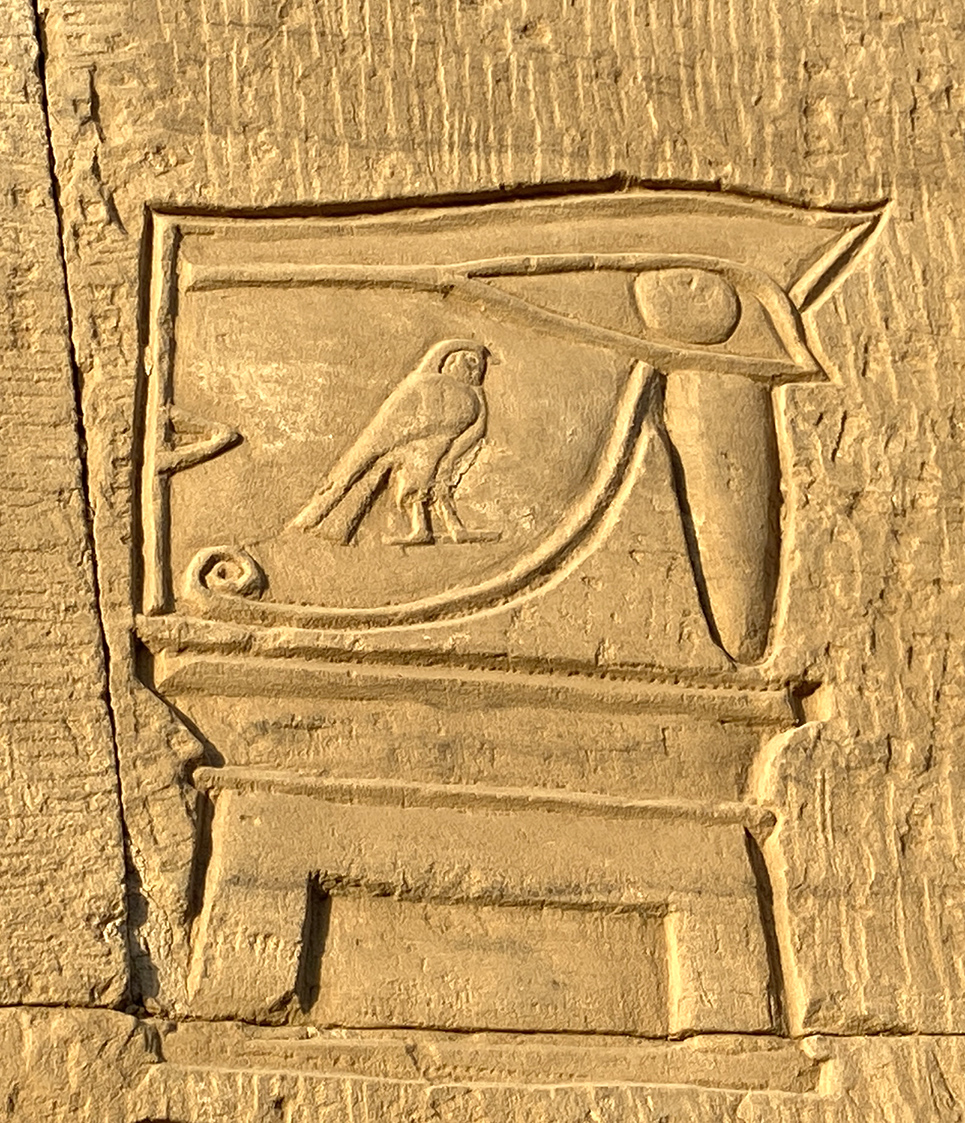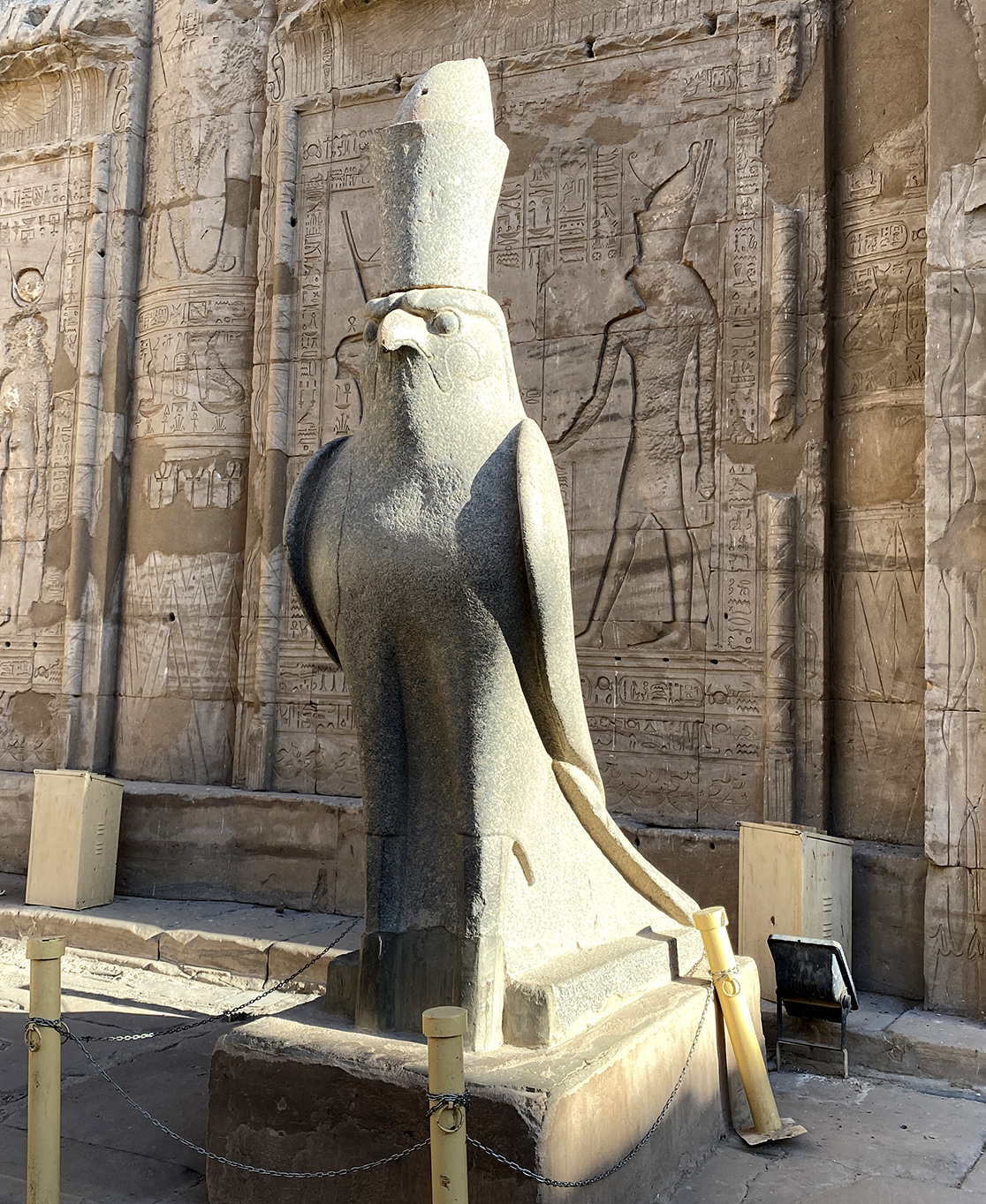Horus
Horus (Heru, Hor, Har in Ancient Egyptian) is one of the most significant ancient Egyptian deities who served many functions, most notably as god of kingship and the sky. He was worshipped from at least the late prehistoric Egypt until the Ptolemaic Kingdom and Roman Egypt. Different forms of Horus are recorded in history, and these are treated as distinct gods by Egyptologists.
Name
Horus is recorded in Egyptian hieroglyphs as ḥr.w "Falcon", 𓅃; the original pronunciation has been reconstructed as /ˈħaːɾuw/ in Old Egyptian and early Middle Egyptian, /ˈħaːɾəʔ/ in later Middle Egyptian, and /ˈħoːɾ(ə)/ in Late Egyptian. Additional meanings are thought to have been "the distant one" or "one who is above, over." As the language changed over time, it appeared in Coptic varieties variously as /hoːɾ/ or /ħoːɾ/ (Ϩⲟⲣ) and was adopted into ancient Greek as Ὧρος Hōros (pronounced at the time as /hɔ̂ːros/). It also survives in Late Egyptian and Coptic theophoric name forms such as Siese "son of Isis" and Harsiese "Horus, Son of Isis."
Horus and the pharaoh
The Pyramid Texts (c. 2400–2300 BCE) describe the nature of the pharaoh in different characters as both Horus and Osiris. The pharaoh as Horus in life became the pharaoh as Osiris in death, where he was united with the other gods. New incarnations of Horus succeeded the deceased pharaoh on earth in the form of new pharaohs.
The lineage of Horus, the eventual product of unions between the children of Atum, may have been a means to explain and justify pharaonic power. The gods produced by Atum were all representative of cosmic and terrestrial forces in Egyptian life. By identifying Horus as the offspring of these forces, then identifying him with Atum himself, and finally identifying the Pharaoh with Horus, the Pharaoh theologically had dominion over all the world.
Origin story
In one tale, Horus is born to the goddess Isis after she retrieved all the dismembered body parts of her murdered husband Osiris, except his penis, which was thrown into the Nile and eaten by a catfish, or sometimes depicted as instead by a crab, and according to Plutarch's account used her magic powers to resurrect Osiris and fashion a phallus to conceive her son (older Egyptian accounts have the penis of Osiris surviving).
After becoming pregnant with Horus, Isis fled to the Nile Delta marshlands to hide from her brother Set, who jealously killed Osiris and who she knew would want to kill their son. There Isis bore a divine son, Horus. As birth, death and rebirth are recurrent themes in Egyptian lore and cosmology, it is not particularly strange that Horus also is the brother of Osiris and Isis, by Nut and Geb, together with Nephthys and Set. This elder Horus is called Hrw-wr - as opposed to Hrw-P-Khrd - the younger Horus, at some point adopted by the Greeks as Harpocrates.
Forms of Horus
Throughout the three thousand years of Egyptian civilization, Horus was depicted in many different forms with many different roles. These various forms may be different manifestations of the same multi-layered deity in which certain attributes or syncretic relationships are emphasized, not necessarily in opposition but complementary to one another, consistent with how the Ancient Egyptians viewed the multiple facets of reality. He was most often depicted as a falcon, most likely a lanner falcon or peregrine falcon, or as a man with a falcon head.
The earliest recorded form of Horus is the tutelary deity of Nekhen in Upper Egypt, who is the first known national god, specifically related to the ruling pharaoh who in time came to be regarded as a manifestation of Horus in life and Osiris in death.
Partial list of forms of Horus
- Heru-ur (Horus the Elder)
- Heru-pa-khered (Horus the Younger)
- Heru-Behdeti (Horus of Behdet)
- Her-em-akhet (Horus in the Horizon)
- Golden Horus Osiris
- Eye of Horus (Wedjat)
Conflict with Set
Horus was told by his mother, Isis, to protect the people of Egypt from Set, the god of the desert, who had killed Horus' father, Osiris. Horus had many battles with Set, not only to avenge his father but to choose the rightful ruler of Egypt. In these battles, Horus came to be associated with Lower Egypt and became its patron.
According to The Contendings of Horus and Seth, Set is depicted as trying to prove his dominance by seducing Horus and then having sexual intercourse with him. However, Horus places his hand between his thighs and catches Set's semen, then subsequently throws it in the river so that he may not be said to have been inseminated by Set. Horus (or Isis herself in some versions) then deliberately spreads his semen on some lettuce, which was Set's favourite food. After Set had eaten the lettuce, they went to the gods to try to settle the argument over the rule of Egypt. The gods first listened to Set's claim of dominance over Horus, and call his semen forth, but it answered from the river, invalidating his claim. Then, the gods listened to Horus' claim of having dominated Set, and call his semen forth, and it answered from inside Set.
However, Set still refused to relent, and the other gods were getting tired from over eighty years of fighting and challenges. Horus and Set challenged each other to a boat race, where they each raced in a boat made of stone. Horus and Set agreed, and the race started. But Horus had an edge: his boat was made of wood painted to resemble stone, rather than true stone. Set's boat, being made of heavy stone, sank, but Horus' did not. Horus then won the race, and Set stepped down and officially gave Horus the throne of Egypt. After the New Kingdom, Set was still considered the lord of the desert and its oases.
In many versions of the story, Horus and Set divide the realm between them. This division can be equated with any of several fundamental dualities that the Egyptians saw in their world. Horus may receive the fertile lands around the Nile, the core of Egyptian civilization, in which case Set takes the barren desert or the foreign lands that are associated with it; Horus may rule the earth while Set dwells in the sky; and each god may take one of the two traditional halves of the country, Upper and Lower Egypt, in which case either god may be connected with either region. Yet in the Memphite Theology, Geb, as judge, first apportions the realm between the claimants and then reverses himself, awarding sole control to Horus. In this peaceable union, Horus and Set are reconciled, and the dualities that they represent have been resolved into a united whole. Through this resolution, the order is restored after the tumultuous conflict.
Historicity of the conflict
Egyptologists have often tried to connect the conflict between the two gods with political events early in Egypt's history or prehistory. The cases in which the combatants divide the kingdom, and the frequent association of the paired Horus and Set with the union of Upper and Lower Egypt, suggest that the two deities represent some kind of division within the country. Egyptian tradition and archaeological evidence indicate that Egypt was united at the beginning of its history when an Upper Egyptian kingdom, in the south, conquered Lower Egypt in the north. The Upper Egyptian rulers called themselves "followers of Horus," and Horus became the tutelary deity of the unified polity and its kings. Yet Horus and Set cannot be easily equated with the two halves of the country. Both deities had several cult centers in each region, and Horus is often associated with Lower Egypt and Set with Upper Egypt.
Other events may have also affected the myth. Before even Upper Egypt had a single ruler, two of its major cities were Nekhen, in the far south, and Nagada, many miles to the north. The rulers of Nekhen, where Horus was the patron deity, are generally believed to have unified Upper Egypt, including Nagada, under their sway. Set was associated with Nagada, so it is possible that the divine conflict dimly reflects an enmity between the cities in the distant past.
Much later, at the end of the Second Dynasty (c. 2890–2686 BCE), Pharaoh Seth-Peribsen used the Set animal to write his serekh name in place of the falcon hieroglyph representing Horus. His successor Khasekhemwy used both Horus and Set in the writing of his serekh. This evidence has prompted conjecture that the Second Dynasty saw a clash between the followers of the Horus king and the worshippers of Set led by Seth-Peribsen. Khasekhemwy's use of the two animal symbols would then represent the reconciliation of the two factions, as does the resolution of the myth.
Celebrations of Horus
The Festival of Victory (Egyptian: Heb Nekhtet) was an annual Egyptian festival dedicated to the god Horus. The Festival of Victory was celebrated at the Temple of Horus at Edfu, and took place during the second month of the Season of the Emergence (or the sixth month of the Egyptian calendar).
The ceremonies which took place during the Festival of Victory included the performance of a sacred drama which commemorated the victory of Horus over Set. The main actor in this drama was the king of Egypt himself, who played the role of Horus. His adversary was a hippopotamus, who played the role of Set. In the course of the ritual, the king would strike the hippopotamus with a harpoon. The destruction of the hippopotamus by the king commemorated the defeat of Set by Horus, which also legitimised the king.
It is unlikely that the king attended the Festival of Victory every year; in many cases he was probably represented by a priest. It is also unlikely that a real hippopotamus was used in the festival every year; in many cases it was probably represented by a model.
The 4th-century Roman author Macrobius mentions another annual Egyptian festival dedicated to Horus in his Chronicon. Macrobius specifies this festival as occurring on the winter solstice. The 4th-century Christian bishop Epiphanius of Salamis also mentions a winter solstice festival of Horus in his Panarion. However, this festival is not attested in any native Egyptian sources.


